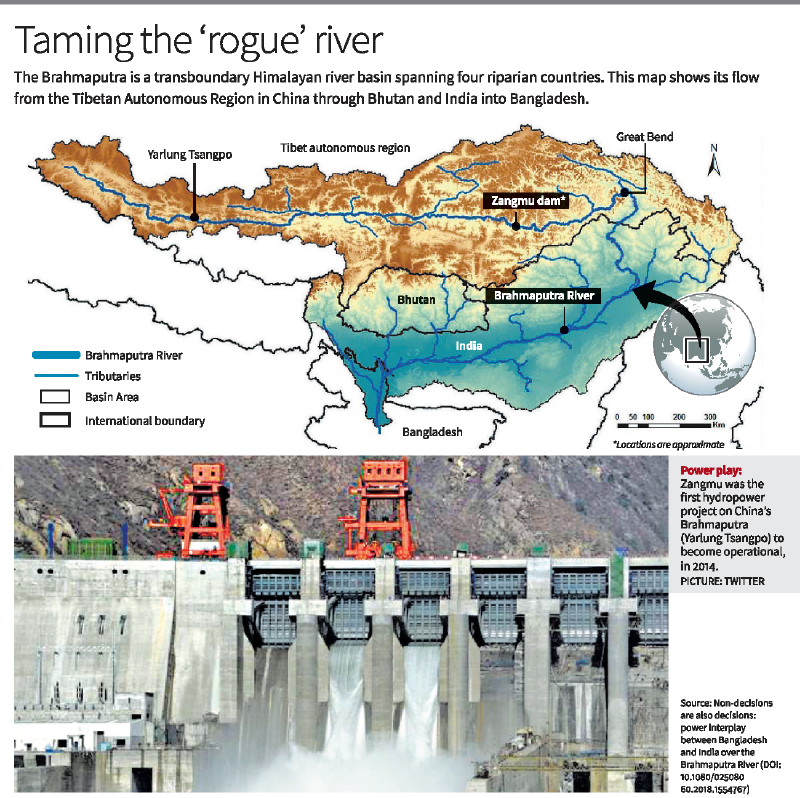Implications of China’s Mega-Dam Project on the Brahmaputra River Basin

- 07 Jan 2025
Introduction:
China has approved the construction of the Yarlung Tsangpo hydropower project, the world's largest hydropower project, with a capacity of 60,000 MW, on the Brahmaputra River in Tibet. This mega-dam, located at the Great Bend in Medog county, has significant geopolitical, environmental, and socio-economic implications for India, Bhutan, and Bangladesh, the downstream riparian countries.
Geographical and Geopolitical Context:
- The Brahmaputra is a transboundary river system flowing through China, India, Bhutan, and Bangladesh.
- China, located at the river’s source in Tibet, is the uppermost riparian nation, controlling water flow into India and Bangladesh.
- All riparian countries, including China, India, Bhutan, and Bangladesh, have proposed major water infrastructure projects in the river basin, which has become a site for geopolitical rivalry, with mega-dams symbolizing sovereignty.
China’s Hydropower Ambitions:
- The Yarlung Tsangpo project is part of China’s 14th Five-Year Plan (2021-2025) and aims to address the country's energy needs while moving towards net carbon neutrality by 2060.
- The river's steep descent from Tibet provides an ideal location for hydroelectricity generation.
- China’s previous mega-projects, like the Three Gorges Dam, highlight the scale of these ambitions but also raise concerns about environmental and social consequences, including ecosystem disruption, displacement, and seismic risks.
Impact on Downstream Communities:
- Water Flow and Agriculture: China’s mega-dam may significantly alter water flow to India, particularly affecting agriculture and water availability in the northeastern regions. India, reliant on the Brahmaputra for irrigation and drinking water, could face disruptions.
- Silt and Biodiversity: The blocking of silt essential for agriculture could degrade soil quality and damage biodiversity in the river basin.
- Seismic Risks: The region’s seismic activity, coupled with the construction of large dams, heightens the risk of catastrophic events such as landslides and Glacial Lake Outburst Floods (GLOFs), which have previously caused devastation in the Himalayas.
Hydropower Competition Between China and India:
- Both China and India are competing to harness the Brahmaputra's potential for hydropower, with India planning its own large project at Upper Siang.
- Bhutan has also proposed several medium-sized dams, raising concerns in downstream countries about cumulative impacts.
- No comprehensive bilateral treaty exists between India and China to regulate shared transboundary rivers, though they have mechanisms for data sharing and discussions on river issues.
Environmental and Regional Concerns:
- The Brahmaputra river basin is an ecologically sensitive region. The construction of large dams threatens the fragile ecosystem, including agro-pastoral communities, biodiversity, and wetlands.
- Tibet’s river systems are vital for the global cryosphere, affecting climate systems, including monsoon patterns. Disruption to these systems could have broader implications for regional and global climate stability.
Challenges in Bilateral Cooperation:
- India and China have struggled with effective coordination on river management. China has shown reluctance to share critical hydrological data, a concern amplified by the lack of a binding agreement.
- The ongoing geopolitical tensions between the two countries, particularly over the border dispute, further complicate cooperation on transboundary water issues.
Recommendations for India:
- Enhanced Cooperation: India should push for renewed agreements and mechanisms for real-time data exchange with China to prevent ecological and socio-economic damage.
- Public Challenges: India needs to challenge China’s claims that its hydropower projects will have minimal downstream impact, ensuring that India's concerns are addressed in international forums.
- Diplomatic Engagement: Water issues should be prioritized in India’s diplomatic engagement with China, emphasizing the importance of transparency and cooperation to ensure mutual benefit and regional stability.
Conclusion:
The Yarlung Tsangpo mega-dam project poses significant risks to the entire Brahmaputra river basin. A collaborative approach, involving transparent dialogue and cooperation among riparian countries, is essential to mitigate the potential adverse impacts on downstream communities and the fragile Himalayan ecosystem.
